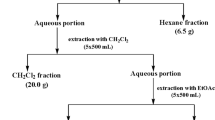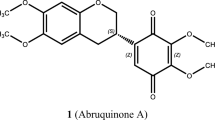Abstract
Leishmaniasis is a major health problem worldwide with different clinical forms that depend on the parasite, the host's immune system, and immune-inflammatory responses. This study aimed to evaluate the secondary metabolites from Artemisia kermanensis Podlech by bioguided fractionation against Leishmania major. The chemical structures of the isolated compounds were determined based on analysis of mass and nuclear magnetic resonance spectra. Antileishmanial activity were determined on promastigotes and amastigotes. Chemical structures of the isolated compound were as 1-Acetoxy-3,7-dimethyl-7-hydroxy-octa-2E,5E-dien-4-one for compound 1 and 5,7-dihydroxy-3′,4′,6-trimethoxyflavone (Eupatilin) for compound 2, and 5,7,3′-Trihydroxy-6,4′,5′-trimethoxyflavone for compound 3. Compound 2 were confirmed by significant activity with IC50 of less than 50 μg/ml for 24 and 48 h in clinical form (amastigotes). Compound 3 demonstrated high susceptibility with an IC50 of less than 30 μg/ml for promastigotes for 24 h. The bioguided fractionation of A. kermanensis resulted the isolation of potent antileishmanial agents with a low toxicity effect on macrophages. These plant metabolites can be a candidate as a drug for treating cutaneous leishmaniasis.





Similar content being viewed by others

Abbreviations
- WHO:
-
World Health Organization
- MPLC:
-
Medium-Performance Liquid Chromatography
- HPLC:
-
High-Performance Liquid Chromatography
- NMR:
-
Nuclear Magnetic Resonance
- MS:
-
Mass spectrometry
- MTT:
-
3-[4,5-Dimethylthiazol-2-yl]-2,5-diphenyl tetrazolium bromide
- DMSO:
-
Dimethyl sulfoxide
- NNN:
-
Novy-Nicolle-Mac Neal
- PBS:
-
Phosphate-buffered saline
- FBS:
-
Fetal bovine serum
References
Aloui Z, Messaoud C, Haoues M et al (2016) Asteraceae Artemisia campestris and Artemisia herba-alba essential oils trigger apoptosis and cell cycle arrest in Leishmania infantum promastigotes. Evid Based Complement Altern Med. https://doi.org/10.1155/2016/9147096
Attioua B, Lagnikab L, Yeoc D et al (2011) In vitro antiplasmodial and antileishmanial activities of flavonoids from Anogeissus leiocarpus (Combretaceae). Int J Pharm Rev Res 11:1–6
Dai M, Peng C, Peng F et al (2016) Anti-Trichomonas vaginalis properties of the oil of Amomum tsao-ko and its major component, geraniol. Pharm Biol 54:445–450
do Monte-Neto RL, Coelho AC, Raymond F et al (2011) Gene expression profiling and molecular characterization of antimony resistance in Leishmania amazonensis. PLoS Negl Trop Dis 5:e1167
El-Khadragy M, Alolayan EM, Metwally DM et al (2018) Clinical efficacy associated with enhanced antioxidant enzyme activities of silver nanoparticles biosynthesized using Moringa oleifera leaf extract, against cutaneous leishmaniasis in a murine model of Leishmania major. Int J Environ Res Public Health 15:1037
Eskandarain A, Sadeghi Dinani M, Changiz O (2020) Leishmanicidal effects of Allium giganteum saponin-rich fraction on Leishmania major. Res J Pharmacogn 7:77–84
Hbika A, Daoudi NE, Bouyanzer A et al (2022) Artemisia absinthium L. aqueous and ethyl acetate extracts: antioxidant effect and potential activity in vitro and in vivo against pancreatic α-amylase and intestinal α-glucosidase. Pharmaceutics 14:481. https://doi.org/10.3390/pharmaceutics14030481
Hua L, Liang S, Zhou Y et al (2022) Artemisinin-derived artemisitene blocks ROS-mediated NLRP3 inflammasome and alleviates ulcerative colitis. Int Immunopharmacol 113:109431. https://doi.org/10.1016/j.intimp.2022.109431
Islamuddin M, Chouhan G, Farooque A et al (2015) Th1-biased immunomodulation and therapeutic potential of Artemisia annua in murine visceral leishmaniasis. PLoS Negl Trop Dis 9:e3321
Jung Y, Kim J-C, Park N-J et al (2018) Eupatilin, an activator of PPARα, inhibits the development of oxazolone-induced atopic dermatitis symptoms in Balb/c mice. Biochem Biophys Res Commun 496:508–514
Kaya ÖM, Akküçük Ş, Yaman M. Alternative treatment studies for leishmaniasisis. Turk J Vet Res 3:45–50
Li Y, Wu H, Dong Y et al (2015) Application of eupatilin in the treatment of osteosarcoma. Oncol Lett 10:2505–2510
Mesa CV, Blandón GA, Muñoz DL et al (2015) In silico screening of potential drug with antileishmanial activity and validation of their activity by in vitro and in vivo studies. J Chem Chem Eng 9:375–402
Mesa LE, Vasquez D, Lutgen P et al (2017) In vitro and in vivo antileishmanial activity of Artemisia annua L. leaf powder and its potential usefulness in the treatment of uncomplicated cutaneous leishmaniasis in humans. Rev Soc Bras Med Trop 50:52–60
Mirzaei F, Bafghi AF, Mohaghegh MA et al (2016) In vitro anti-leishmanial activity of Satureja hortensis and Artemisia dracunculus extracts on Leishmania major promastigotes. J Parasit Dis 40:1571–1574
Moghaddas E, Abouhosseini Tabari M, Youssefi MR et al (2017) Antileashmanial activity of Artemisia sieberi essential oil against Leishmania infantum in vitro. Future Nat Prod 3:40–46
Mojarrab M, Naderi R, Afshar FH (2015) Screening of different extracts from Artemisia species for their potential antimalarial activity. Iran J Pharm Res IJPR 14:603
Monge-Maillo B, López-Vélez R (2013) Therapeutic options for visceral leishmaniasis. Drugs 73:1863–1888. https://doi.org/10.1007/s40265-013-0133-0
Monzote L, Piñón A, Scull R, Setzer WN (2014) Chemistry and leishmanicidal activity of the essential oil from Artemisia absinthium from Cuba. Nat Prod Commun 9:1934578X1400901236
Numonov S, Sharopov F, Salimov A et al (2019) Assessment of Artemisinin contents in selected artemisia species from Tajikistan (Central Asia). Medicines 6:23. https://doi.org/10.3390/medicines6010023
Oliaee RT, Sharifi I, Bamorovat M et al (2020) The potential role of nicotinamide on Leishmania tropica: an assessment of inhibitory effect, cytokines gene expression and arginase profiling. Int Immunopharmacol 86:106704
Read A, Hurwitz I, Durvasula R (2013) Leishmaniasis: an update on a neglected tropical disease. In: Dynamic models of infectious diseases. Springer, pp 95–138
Rustaiyan A, Faridchehr A (2021) Constituents and biological activities of selected genera of the Iranian Asteraceae family. J Herb Med 25:100405. https://doi.org/10.1016/j.hermed.2020.100405
Rustaiyan A, Bamonieri A, Raffatrad M et al (1987) Eudesmane derivatives and highly oxygenated monoterpenes from Iranian Artemisia species. Phytochemistry 26:2307–2310
Santos AO, Ueda-Nakamura T, Dias Filho BP et al (2008) Effect of Brazilian copaiba oils on Leishmania amazonensis. J Ethnopharmacol 120:204–208
Sharma M, Sehgal R, Kaur S (2012) Evaluation of nephroprotective and immunomodulatory activities of antioxidants in combination with cisplatin against murine visceral leishmaniasis. PLoS Negl Trop Dis 6:e1629
Tamargo B, Monzote L, Piñón A et al (2017) In vitro and in vivo evaluation of essential oil from Artemisia absinthium L. formulated in nanocochleates against cutaneous leishmaniasis. Medicines 4:38. https://doi.org/10.3390/medicines4020038
Tasdemir D, Kaiser M, Brun R et al (2006) Antitrypanosomal and antileishmanial activities of flavonoids and their analogues: in vitro, in vivo, structure-activity relationship, and quantitative structure-activity relationship studies. Antimicrob Agents Chemother 50:1352–1364
Wink M (2015) Modes of action of herbal medicines and plant secondary metabolites. Medicines 2:251–286
Yazdiniapour Z, Yegdaneh A, Akbari S (2021) Isolation and characterization of methylated flavones from Artemisia kermanensis. Adv Biomed Res 10:23
Yun C, Jung Y, Chun W et al (2016) Anti-inflammatory effects of artemisia leaf extract in mice with contact dermatitis in vitro and in vivo. Mediat Inflamm. https://doi.org/10.1155/2016/8027537
Zamanai Taghizadeh Rabe S, Iranshahi M, Rastin M et al (2015) In vitro immunomodulatory properties of a sesquiterpene lactone-bearing fraction from Artemisia khorassanica. J Immunotoxicol 12:223–230
Acknowledgements
This work was supported by Isfahan University of Medical Sciences, Isfahan, Iran (Grant No. 3991071)
Funding
This research was funded by Isfahan University of Medical Sciences, project number 3991071.
Author information
Authors and Affiliations
Contributions
SS performed the experimental and wrote the manuscript draft; SS revised the manuscript, conducted the parasitological tests and analysed the data; ZY revised the manuscript and conducted the plant extraction, fractionation, purification and identification of compounds.
Corresponding author
Ethics declarations
Conflict of interest
There is no conflict of interest among the authors.
Ethics approval
This study was approved by the ethics committee of Isfahan University of Medical Sciences (IR.MUI.RESEARCH.REC.1399.797).
Additional information
Publisher's Note
Springer Nature remains neutral with regard to jurisdictional claims in published maps and institutional affiliations.
Rights and permissions
Springer Nature or its licensor (e.g. a society or other partner) holds exclusive rights to this article under a publishing agreement with the author(s) or other rightsholder(s); author self-archiving of the accepted manuscript version of this article is solely governed by the terms of such publishing agreement and applicable law.
About this article
Cite this article
Soleimanifard, S., Saeedi, S. & Yazdiniapour, Z. Isolation of potent antileishmanial agents from Artemisia kermanensis Podlech using bioguided fractionation. J Parasit Dis 47, 297–305 (2023). https://doi.org/10.1007/s12639-023-01569-8
Received:
Accepted:
Published:
Issue Date:
DOI: https://doi.org/10.1007/s12639-023-01569-8



